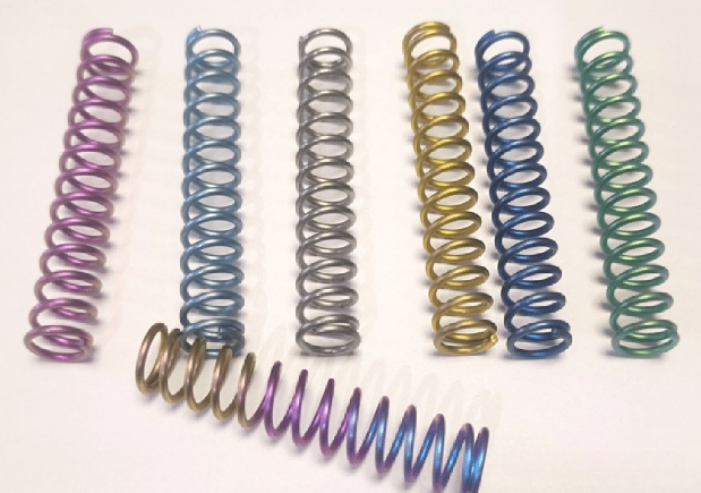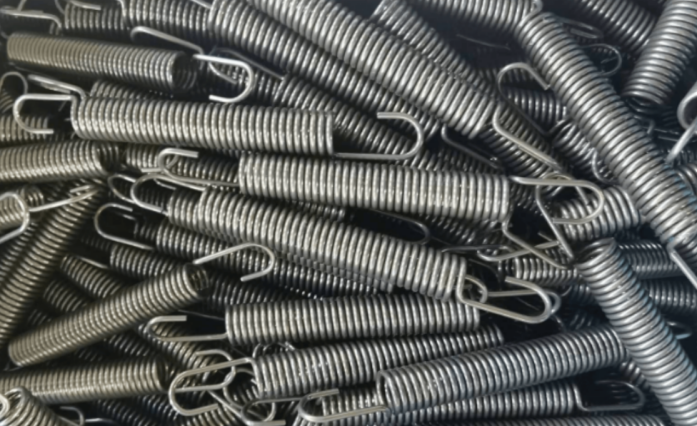Precision deployment and retraction on aircraft landing gear, Gentle support for life-sustaining in medical device……Titanium alloy springs, with their unique performance advantages, are becoming indispensable key components in numerous high-end fields. This article will delve into the performance characteristics, manufacturing challenges, and solutions for titanium alloy springs, while showcasing their diverse application scenarios.

I. Outstanding Performance: Demonstrating Multi-Dimensional Advantages
(1) High Specific Strength Combined with High Elasticity
Titanium alloys (such as TC4 and TA18) exhibit formidable comprehensive properties. Their strength rivals that of steel, with tensile strengths reaching 800–1100 MPa, yet their density is only 60% that of steel. This low-density, high-strength characteristic enables titanium alloy springs to achieve significant weight reduction while maintaining equivalent load-bearing capacity. Simultaneously, their lower elastic modulus (110–120 GPa) enables greater elastic deformation capacity, higher elastic specific work, and superior energy storage capabilities compared to steel. In applications requiring high energy absorption—such as shock absorber springs—titanium alloy springs absorb and release energy more efficiently, providing stable elastic support for equipment.
(2) Exceptional Corrosion Resistance
Titanium alloys exhibit “immunity” to corrosive media such as seawater, chloride ions, and bodily fluids. In marine environments, conventional metal springs are prone to rust and damage from seawater corrosion, compromising equipment performance. Titanium alloy springs, however, deliver long-term stable operation without requiring additional anti-corrosion treatment. In medical applications, such as stents and other implants, titanium alloy springs do not chemically react with bodily fluids. This prevents harmful substances from corrosive reactions entering the body, safeguarding patient health and safety.
(3) Exceptional Fatigue Life
Titanium alloys exhibit a fatigue limit reaching 50%–60% of their tensile strength, compared to approximately 40% for steel. This means that under high-frequency dynamic loads—such as in aircraft engine valve springs—titanium alloy springs can withstand more cycles without fatigue failure. Their extended service life reduces equipment maintenance costs and replacement frequency, enhancing reliability and safety.
(4) Non-Magnetic and Excellent Biocompatibility
Titanium alloys are non-magnetic, enabling them to function normally in MRI (Magnetic Resonance Imaging) environments without interfering with imaging results. Additionally, titanium alloys such as TA1 pure titanium or TC4 ELI hold ISO 5832-3 medical certification, demonstrating excellent biocompatibility that does not trigger human rejection reactions. They are widely used in medical implant applications.
II. Refined Craftsmanship: Overcoming Challenges to Forge Excellence
(1) Material Selection: Precise Matching to Requirements
Different application scenarios demand distinct performance characteristics from titanium alloy springs, necessitating the precise selection of suitable alloy materials. TC4 (Ti-6Al-4V) offers outstanding comprehensive properties at a moderate cost, making it suitable for most spring applications. TA18 (Ti-3Al-2.5V) offers superior high-temperature resistance, suitable for environments ≤450°C, such as engine valve springs. Pure titanium (TA1/TA2) exhibits exceptional ductility but lower strength, making it ideal for low-load springs where high strength isn’t critical but good elasticity is required.
(2) Forming Processes: Challenges in Both Cold and Hot Forming
Cold Forming: Suitable for wire diameters ≤6 mm, such as medical micro-springs. However, titanium alloys exhibit rapid cold work hardening, necessitating intermediate annealing (700–800°C) during cold forming to restore material plasticity. Significant springback (20%-30% higher than steel) poses a key challenge. This is addressed through die compensation design or multiple forming passes to ensure dimensional accuracy.
Hot Forming: Temperature range: 750–900°C (TC4) or 700–850°C (TA18). Inert gas shielding is required during hot forming to prevent oxidation. The advantages of hot forming include the ability to process large-sized springs, such as aviation coil springs, while reducing residual stresses and enhancing spring performance stability.
(3) Heat Treatment: Key to Optimizing Performance
Stress Relief Annealing: Annealing at 500–650°C for 1–2 hours eliminates cold working stresses, enhances dimensional stability of springs, and reduces deformation during use.
Solution Treatment + Aging (Only for α-β Alloys like TC4): First perform solution treatment (900–950°C followed by water quenching), then aging treatment (480–550°C × 4–8 hours). This enhances spring strength by 10%–15%, further increasing its load-bearing capacity.
(4) Surface Treatment: Enhancing Performance and Lifespan
Shot Peening: Creates a compressive stress layer on the spring surface up to 0.1–0.2 mm deep, effectively extending fatigue life and improving resistance to fatigue fracture.
Anodizing: Generates a TiO₂ coating (5–20 μm thick), which not only improves the spring’s wear resistance but also enhances its electrical insulation properties. This treatment is suitable for applications requiring both wear resistance and electrical insulation.
(5) Welding and Joining: Ensuring Structural Stability
Laser welding is commonly used for joining closed-end springs. During the welding process, heat input must be strictly controlled to prevent coarsening and embrittlement of the β phase, which could compromise spring performance. Precise welding techniques ensure the structural stability and reliability of the spring.
III. Wide Applications: Demonstrating Versatility Across Multiple Fields
(1) Aerospace: Reliable Support Soaring Through the Skies
In the aerospace sector, titanium alloy springs play a vital role. Landing gear springs made from TC4 material undergo hot forming and aging treatment, achieving a fatigue life exceeding 10⁷ cycles. They withstand immense impact forces and frequent load changes during aircraft takeoffs and landings. Engine valve springs utilize TA18 material, cold-drawn wire, and shot peening processes, withstanding temperatures up to 450°C to ensure stable engine operation in high-temperature environments.
(2) Medical Devices: Gentle Strength Safeguarding Life
The medical device sector demands exceptionally high standards for material biocompatibility and performance stability. Vascular stent springs utilize TA1 cold-drawn wire with diameters as small as 0.1–0.3 mm. Electrolytic polishing achieves a surface roughness of Ra < 0.1 μm, ensuring smoothness that prevents vascular damage. Their excellent elasticity and biocompatibility provide stable vascular support, aiding patient recovery.
(3) Automotive Industry: The Lightweight Choice for Enhanced Performance
Recent years have witnessed explosive growth in titanium alloy spring applications within the automotive sector. Racing suspension springs crafted from TC4 material reduce weight by 40% compared to steel springs while offering adjustable stiffness. This weight reduction lowers energy consumption, enhances acceleration performance, and improves handling. The adjustable stiffness allows optimization for varying track conditions and driving demands, delivering an enhanced driving experience for racers.
IV. Comparison with Steel Springs: Advantages and Challenges Coexist
Compared to steel springs (such as 60Si2MnA), titanium alloy springs offer distinct advantages. With a density of 4.5 g/cm³, they are 40% lighter than steel springs, offering substantial potential for weight reduction. Their fatigue limit ranges from 450 to 600 MPa, exceeding the 300 to 400 MPa of steel springs, resulting in extended service life. Regarding corrosion resistance, titanium alloy springs require no maintenance and are suitable for marine and bodily fluid environments, whereas steel springs necessitate plating or stainless steel, increasing costs. However, titanium alloy springs also face the challenge of high costs, including material and processing expenses.

V. Looking Ahead: Innovation-Driven Development
Titanium alloy springs demonstrate broad application prospects in high-end fields due to their lightweight properties, high fatigue life, and corrosion resistance. However, challenges such as springback control, thermal processing oxidation protection, and high costs require further resolution. Moving forward, the development of low-cost β-type titanium alloys (such as Ti-3Al-8V-6Cr-4Mo-4Zr) will become a key trend. These alloys can further enhance cold formability, reduce production costs, and drive the widespread adoption of titanium alloy springs across more industries. With continuous technological advancement and innovation, titanium alloy springs are poised to become the mainstream choice for high-end applications, providing stronger support for development across various industries.
